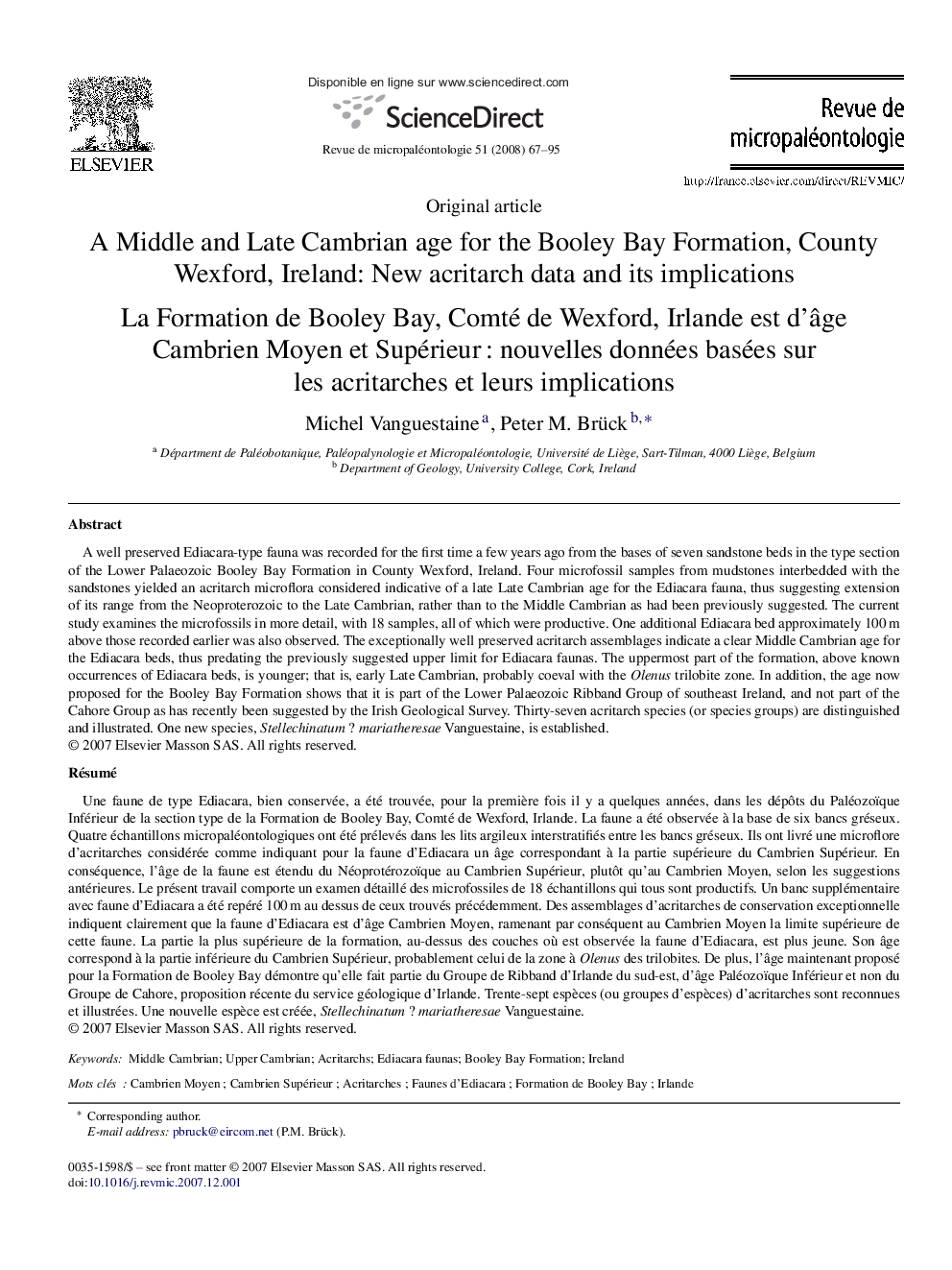| کد مقاله | کد نشریه | سال انتشار | مقاله انگلیسی | نسخه تمام متن |
|---|---|---|---|---|
| 4751517 | 1361079 | 2008 | 29 صفحه PDF | دانلود رایگان |

A well preserved Ediacara-type fauna was recorded for the first time a few years ago from the bases of seven sandstone beds in the type section of the Lower Palaeozoic Booley Bay Formation in County Wexford, Ireland. Four microfossil samples from mudstones interbedded with the sandstones yielded an acritarch microflora considered indicative of a late Late Cambrian age for the Ediacara fauna, thus suggesting extension of its range from the Neoproterozoic to the Late Cambrian, rather than to the Middle Cambrian as had been previously suggested. The current study examines the microfossils in more detail, with 18 samples, all of which were productive. One additional Ediacara bed approximately 100 m above those recorded earlier was also observed. The exceptionally well preserved acritarch assemblages indicate a clear Middle Cambrian age for the Ediacara beds, thus predating the previously suggested upper limit for Ediacara faunas. The uppermost part of the formation, above known occurrences of Ediacara beds, is younger; that is, early Late Cambrian, probably coeval with the Olenus trilobite zone. In addition, the age now proposed for the Booley Bay Formation shows that it is part of the Lower Palaeozoic Ribband Group of southeast Ireland, and not part of the Cahore Group as has recently been suggested by the Irish Geological Survey. Thirty-seven acritarch species (or species groups) are distinguished and illustrated. One new species, Stellechinatum ? mariatheresae Vanguestaine, is established.
RésuméUne faune de type Ediacara, bien conservée, a été trouvée, pour la première fois il y a quelques années, dans les dépôts du Paléozoïque Inférieur de la section type de la Formation de Booley Bay, Comté de Wexford, Irlande. La faune a été observée à la base de six bancs gréseux. Quatre échantillons micropaléontologiques ont été prélevés dans les lits argileux interstratifiés entre les bancs gréseux. Ils ont livré une microflore d’acritarches considérée comme indiquant pour la faune d’Ediacara un âge correspondant à la partie supérieure du Cambrien Supérieur. En conséquence, l’âge de la faune est étendu du Néoprotérozoïque au Cambrien Supérieur, plutôt qu’au Cambrien Moyen, selon les suggestions antérieures. Le présent travail comporte un examen détaillé des microfossiles de 18 échantillons qui tous sont productifs. Un banc supplémentaire avec faune d’Ediacara a été repéré 100 m au dessus de ceux trouvés précédemment. Des assemblages d’acritarches de conservation exceptionnelle indiquent clairement que la faune d’Ediacara est d’âge Cambrien Moyen, ramenant par conséquent au Cambrien Moyen la limite supérieure de cette faune. La partie la plus supérieure de la formation, au-dessus des couches où est observée la faune d’Ediacara, est plus jeune. Son âge correspond à la partie inférieure du Cambrien Supérieur, probablement celui de la zone à Olenus des trilobites. De plus, l’âge maintenant proposé pour la Formation de Booley Bay démontre qu’elle fait partie du Groupe de Ribband d’Irlande du sud-est, d’âge Paléozoïque Inférieur et non du Groupe de Cahore, proposition récente du service géologique d’Irlande. Trente-sept espèces (ou groupes d’espèces) d’acritarches sont reconnues et illustrées. Une nouvelle espèce est créée, Stellechinatum ? mariatheresae Vanguestaine.
Journal: Revue de Micropaléontologie - Volume 51, Issue 1, January–March 2008, Pages 67–95